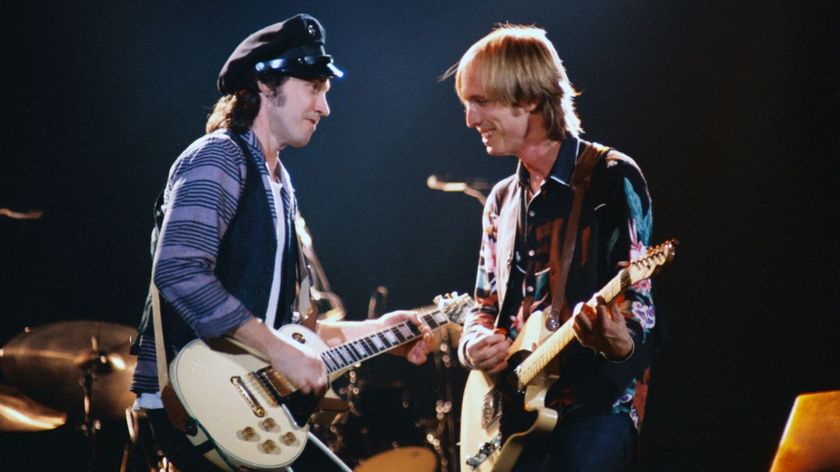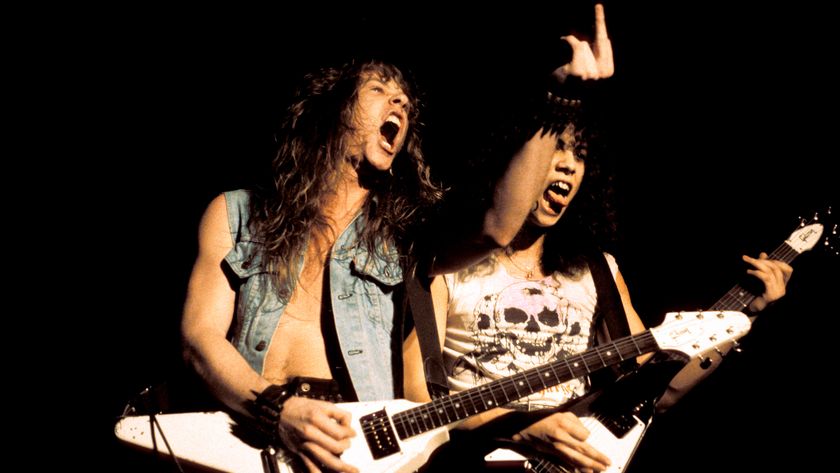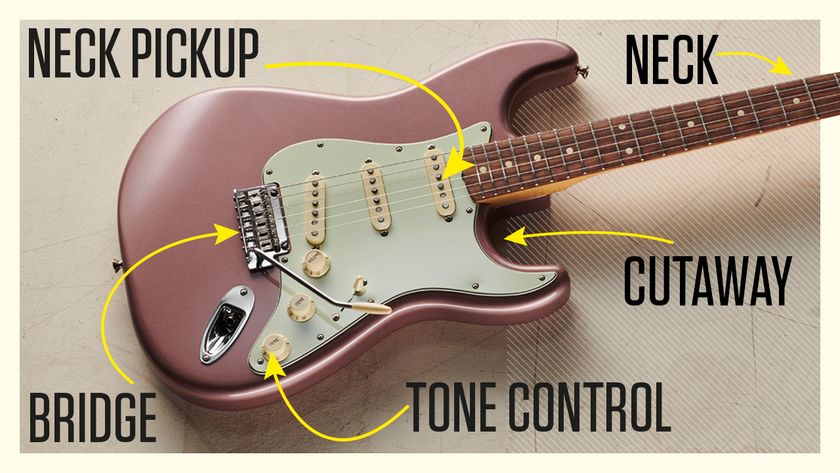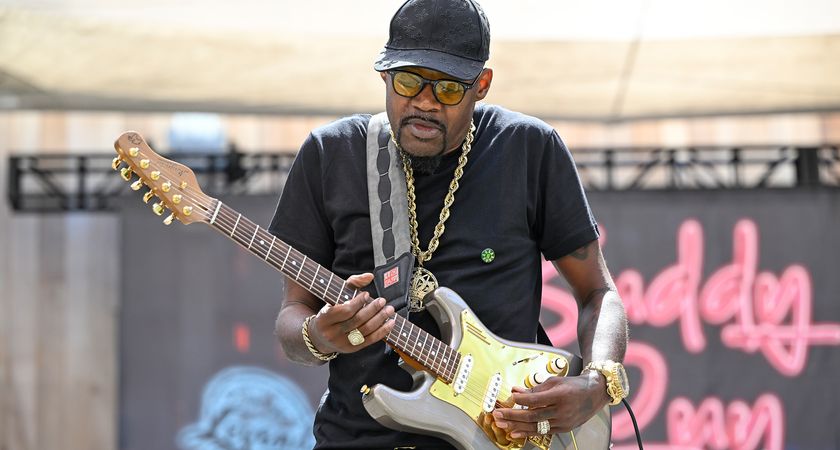The glitterball guitar heroes of ’70s funk were masters of rhythm guitar – and learning their string-popping techniques and snappy chord shapes will make you a better player
Unpacking the techniques pioneered by the likes of Nile Rodgers, Hamish Stuart and Claydes Charles Smith
![Three funk guitar maestros [l-r]: Hamish Stuart of Average White Band crouches down to play his Telecaster; Nile Rodgers of Chic gives the audience some love; and Claydes Charles Smith of Kool and the King holds it down with sunglasses on in an archive B/W live shot.](https://cdn.mos.cms.futurecdn.net/JiG8AhR8Xa2U8sYe6rBRm7-1200-80.jpg)
Welcome to our 1970s based funk lesson, the aim of which is to arm you with the skills you’ll need to create great ’70s-style funk parts.
The first technique to examine is 16th-note strumming, which forms the basis of funk rhythm guitar and we have some easy drills to tighten up your strumming hand.The pattern consists of alternating down and up strums and, as the name suggests, you’ll find 16 strums in a bar of 4/4.
Let’s first establish the pattern of alternating down and up strokes. Lay the fingers of the fretting hand lightly on the strings to damp them. Our strumming pattern is counted 1–e-&-a, 2–e-&-a, 3–e-&-a, 4–e-&-a and starts on a down strum. Once we have established this framework we can mix up the rhythms and start to create far more funky sounding parts.
The easiest way is to finger a simple octave (Example 1). Keep the strumming hand going and only press the octave down when you want to hear them sound. Having all the muted strums in the part can be distracting, so the final stage is to remove some of these, and here’s where the skill lies.
Keep the strumming hand going up and down regardless, hovering over the strings to act as a metronome. Remember the pattern remains the same, it’s just the omission of various muted strokes and the fingers fretting the octave that creates our rhythm.
Closely related is 16th-note popping. This is often just a single note that plays a funky muted riff. The riff can be spiced up with double-stops and unison bends as required. All these strumming and popping ideas can be augmented using a wah-wah pedal, as typified by Isaac Hayes’ theme from Shaft.
The key ingredients of funk are major and minor pentatonic scales and 7th chords, as you’ll hear in this month’s audio examples. dominant 7ths can be augmented by 9th or 13th intervals, and more tension can be created by altering these extensions to form chords like the 7#9.
Another trick is to create the classic dominant 9sus4 sound by using a Major triad with a bass note a tone above the root. So, to create D9sus4, play a C chord with a D note bass (also known as C/D).
This lesson’s audio starts with five examples containing 16th-note rhythms, wah-wah, double-stops, unison bends and a mix of long and short 7th chords.
Each four-bar idea is notated and our demo track has one bar of four clicks to separate the examples. These will not only provide variety but also essential components that are typical of classic funk vocabulary.
Following our technique primer we have five jam tracks that place some of the example ideas into functioning performance pieces.
We have picked five iconic funk bands and guitarists for inspiration, and these are Chic (with Nile Rodgers who’s still treading the boards with the band), Average White Band (featuring Hamish Stuart), Kool & The Gang (with Claydes Charles Smith), Earth Wind & Fire (with the incredible Al McKay), finishing with Parliament (and funkster extraordinaire, Eddie Hazel).
Lastly, don’t mistake funk guitar as a niche subject, as all the techniques seen here can be applied to almost any other style. Now let’s get your groove on!
Get the tone
Amp Settings: Gain 3, Bass 6, Middle 7, Treble 7, Reverb 1
Plug your guitar into a clean amp and you’re good to go. If using twin humbuckers select the middle option. With three single-coils all positions sound great (Nile Rodgers loves the neck+middle pickup).
A compressor pedal will even out the dynamics, a phaser pedal adds instant retro flavour, a fuzz pedal is stylistically perfect, and a touch of reverb is the icing on the cake.
Examples 1-5
Example 1. Claydes Charles Smith-style 16th-note funky octaves
Lightly spread your fingers across the strings to create a heavy mute for the octaves. Keep your strumming hand moving and only strum the strings when required.
Example 2. Charles Pitts-style wah-wah (Isaac Hayes)
Here we are augmenting our 16th-note strumming with the wah pedal. To accentuate the ‘whacka-chicka’ strum either the bass strings or the top three strings.
Example 3. Hamish Stuart-style popping lines
Make sure you pick all of the notes here. The muted sound can come from a light palm mute, or from lightly fretting the notes to make them short and percussive.
Example 4. Adding rhythm to sustained chords with the wah-wah
This example is one of the simplest to play, but can sound very effective in a track. Strum the chord and then rock the wah-wah in a quarter-note triplet rhythm.
Example 5. Using extended chords like Nile Rodgers
Rodgers is a funk master and his style of strumming often features sophisticated chords and a tight rhythm hand. Using a thin pick is a classic Nile Rodgers choice.
Jam Track 1. Earth, Wind & Fire style
Our first performance track is inspired by Earth Wind & Fire tracks like Mighty Mighty. Guitarist Al McKay was a master of mixing up 16th-note strumming with popping lines.
The fingering we are using for the D9 chord makes moving to the C/D chord (aka D9sus4) easy. Another key feature of this track is sliding into chords from a semitone below. This is a popular trick in many styles and really adds to the delivery.
Jam Track 2. Average White Band style
Hamish Stuart is a great rhythm guitarist (as is Onnie McIntyre) and our example is inspired by AWB tracks like Cut The Cake and Pick Up The Pieces. Again the double-stops are delivered with a finger slide from a semitone below.
The popping patterns are based around the E minor pentatonic scale, but can be augmented by adding chromatic notes. The E7#9 chord is a popular fingering for funk and funk-rock styles (for sonic reference think Hendrix’s Purple Haze).
Jam Track 3. Kool & the Gang style
Kool & The Gang achieved worldwide chart success in the 1980s. However their early ’70s recordings had more of a hard-core funk flavour. Our example is inspired by Claydes Charles Smith and Dennis D T Thomas’ funky rhythm work on tracks like Celebration and Ladies Night.
There are three main guitar elements that run through the track: a low popping line, funky octaves and 16th-note strumming with a double-stop stab. To give you a chance to try out all the ideas the tab features the parts that have been removed in the backing track. However you may prefer just to stick with one part for the whole of the piece.
Jam Track 4. Chic/Nile Rodgers style
Niles Rodgers is a bona fide hit maker (and even named his famous white Stratocaster as such), and has collaborated with a diverse collection of bands and artists right up to this day, including Duran Duran, Madonna, David Bowie, Stevie Winwood and Daft Punk.
In the 1970s his main projects were Chic and Sister Sledge, and our track is inspired by tracks like Le Freak and Thinking Of You.
Experiment by alternating your strumming between the lower strings in the chord and the treble strings, to provide some variety. This is a great way to develop that signature Nile Rodgers ‘bounce’.
Example 5. Parliament style
Our final track is a wah-wah pedal workout in the style of bands like Parliament and Funkadelic. The main riff is constructed using E minor pentatonic scale, and to get more mileage out of this idea we can take it up an octave.
The E9 chord is a funk favourite and it’s easy to move this up a semitone to F9 for some variety. There is an opportunity to play some simple funky lead lines in the final four bars, too. Again the scale of choice is E minor pentatonic.
Get The Pick Newsletter
All the latest guitar news, interviews, lessons, reviews, deals and more, direct to your inbox!
Jon Bishop is a UK-based guitarist and freelance musician, and a longtime contributor to Guitar Techniques and Total Guitar. He's a graduate of the Academy of Contemporary Music in Guildford and is touring and recording guitarist for British rock 'n' roll royalty Shakin’ Stevens.

“This is a technique that has been used to great effect by some of my biggest blues heroes”: By thumb-picking bass notes while playing a melody, you can be your own rhythm section – Jared James Nichols shows you how
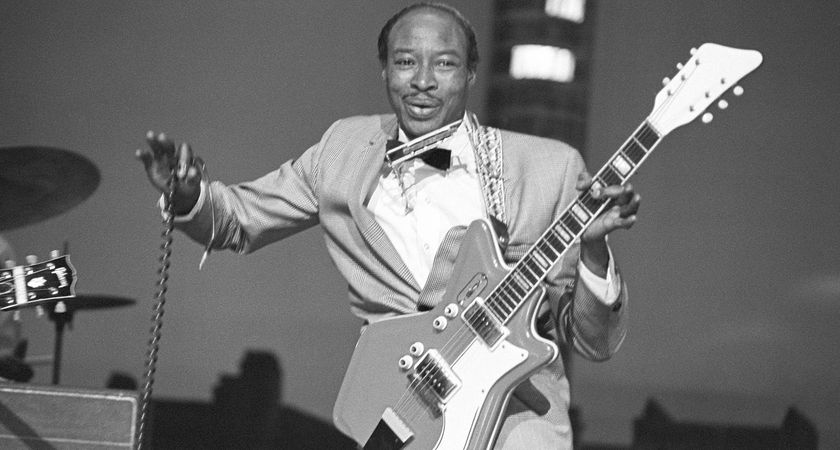
Jimmy Reed was one of the most influential blues guitarists to ever live – and his fingerpicking style makes an incredible launching pad for improvisation



